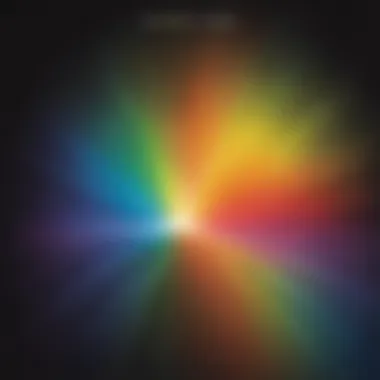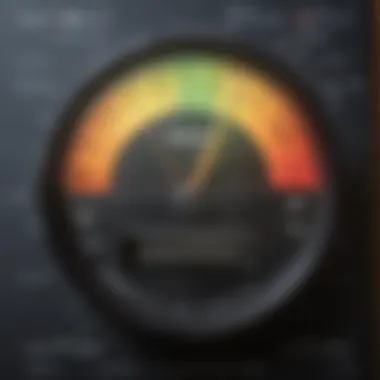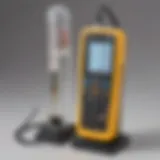Understanding Brightness: A Fun Science Guide


Intro
Brightness is a vital component of our world. It affects how we see things and even influences our mood. But how do we measure this important part of science? This article will cover various aspects related to measuring brightness, especially aimed at young science enthusiasts. We will look at interesting facts, fun experiments, and how brightness plays a role in different fields of study. Young learners will find this information engaging and easy to understand.
Let's start this journey by discovering some fascinating science fun facts!
Science Fun Facts
Interesting Trivia and Facts
- Light Travels Fast: Did you know that light travels at a speed of about 299,792 kilometers per second in a vacuum? This means that it takes only a bit over eight minutes for sunlight to reach Earth from the Sun.
- Brightness and Color: The brightness of an object sometimes changes based on its color. Objects that are white or bright tend to reflect more light than darker objects, which absorb more light.
Quirky Science Stories
There is a strange phenomenon known as "the blue sky effect." When sunlight enters Earth's atmosphere, it scatters, making the sky appear blue. This scattering is due to the tiny air molecules that interact with sunlight.
Amazing Science Records
The brightest natural light source on Earth is the Sun. However, did you know that the brightest artificial light source is created in a laboratory using lasers? These lasers can produce light that is millions of times brighter than the sunlight we experience outdoors.
Thought-Provoking Questions
- Why do you think the Sun looks so bright in the sky?
- How do different materials affect the brightness of colors we can see?
Discover the Wonders of Science
Learning about light and brightness can reveal many wonderful things in the world. Here are some concepts young learners can explore:
Exploring Various Scientific Concepts
Understanding light involves concepts like reflection, refraction, and absorption. These principles explain how we see colors and brightness.
Educational Videos and Animations
There are many resources online where children can watch videos about brightness. Websites like Britannica offer interactive content tailored to young minds.
Interactive Learning Tools
Using applications or websites designed for education, like Reddit's science pages, can enhance the learning experience. Kids can interact with science and learn through games and activities.
Real-Life Applications of Science
Brightness plays a key role in various fields such as photography, astronomy, and even safety. Understanding how to measure it can help in everyday situations.
Science Quiz Time
Engagement through quiz or questions can help reinforce the learning of young enthusiasts.
Interactive Quizzes
Quizzes can include simple questions such as:
- What is the fastest thing in the universe? (Hint: light)
- Which color tends to appear brighter, red or white?
Multiple Choice Questions
- What unit do we use for measuring brightness?
A) Kelvin
B) Lumens
C) Grams - Which object reflects more light?
A) A black piece of paper
B) A white board
Brain Teasers and Puzzles
Puzzles can also help develop critical thinking. For example, ask kids to match colors with their brightness levels and see which one is the brightest!
Learning Through Gamification
Incorporating elements of games can make learning about brightness more exciting. Consider creating a simple game where kids can "collect" different brightness levels by matching objects of different colors.
Science Experiment Showcase
Nothing beats hands-on learning when it comes to science. Here are some fun experiments related to brightness.
Fun and Engaging Experiments
One excellent experiment is the "Light Reflection Test." Try using a flashlight and different surfaces to see how light reflects differently.
Step-by-Step Instructions
- Gather a flashlight, a shiny mirror, and a black piece of paper.
- In a dark room, turn on the flashlight and shine it on the mirror.
- Observe how the light reflects off the mirror and onto the wall.
- Now shine the light on the black paper. Notice the difference in brightness.
Materials List
- Flashlight
- Mirror
- Black paper
- Dark room
Safety Tips and Precautions


Always remember to not look directly into the bright light of the flashlight. Keep it pointed away from your eyes to ensure safety.
Understanding Brightness
Brightness is a fundamental concept in the study of light and its properties. This section is crucial because it lays the groundwork for young science enthusiasts to comprehend how brightness affects many areas of life and science, from photography to astronomy. Understanding this topic helps in learning how to measure light and its impact on our environment.
Definition of Brightness
Brightness typically refers to the perception of light emitted from a source. It is how much light we see, and it can vary depending on several factors, including distance from the light source and the characteristics of the surrounding surface. Scientifically, brightness is often quantified to help us better understand how light interacts with objects.
The Role of Light
Light plays a significant role in our daily experiences. It allows us to see and interact with our environment. Without light, we would be limited to darkness. Light can reflect, refract, and absorb, changing how we perceive brightness. Also, studying light's behavior is vital for various scientific fields, enhancing our knowledge of physics, biology, and even art.
Types of Brightness
When measuring brightness, there are two important types to consider: intrinsic brightness and apparent brightness. These concepts help in understanding how light behaves in different scenarios.
Intrinsic Brightness
Intrinsic brightness refers to the actual amount of light emitted by a source. This measure does not change regardless of how far away the light source is or what else is around it. Understanding intrinsic brightness is beneficial because it allows scientists to categorize light sources based on their emission properties. A key characteristic of intrinsic brightness is that it gives a clear idea of the energy output of a source, like a light bulb or a star. Its unique feature is its ability to remain constant, providing a stable reference point for measurements.
Apparent Brightness
On the other hand, apparent brightness is how bright a light source appears from a specific distance. This perception can change based on factors like distance and surrounding conditions. A key characteristic of apparent brightness is its relativity, meaning it is dependent on the observer's position and the environment. This makes it a popular choice in applications like photography, where the distance of the light source plays a crucial role. The unique advantage of apparent brightness is that it helps in understanding how light reaches us in everyday scenarios, allowing us to make adjustments based on visual perception.
Historical Context
Understanding the historical context of brightness measurement is crucial for comprehending the evolution of light science. This section will discuss how early humans perceived light, the significance of their observations, and how these observations set the groundwork for modern brightness measurements. Recognizing where we came from helps us appreciate the advancements we have today.
Early Measurements of Light
Ancient civilizations had a natural curiosity about light. They noticed that some objects reflected light better than others. Many cultures developed methods to track light. The Egyptians, for example, used sundials to measure time based on sunlight. This early form of measurement illustrated their understanding of light changes throughout the day.
As time passed, the Greeks studied shadows and angles of light using simple tools. They were among the first to mathematically analyze light and its effects. Figures like Archimedes contributed to the early understanding of reflection and refraction, essential concepts in brightness measurement.
Measurements were often based on visual observation and subjective comparisons. Light from the sun was seen as a standard, while candle flames and torches provided basic benchmarks for artificial light. This led to a common understanding of what ‘bright’ meant, although it varied from person to person.
In medieval times, the invention of lenses allowed for further study. Optics developed, leading to the realization that light could be manipulated, ultimately prompting more precise measurements. The focus shifted from mere perception to quantitative analysis, paving way for future discoveries.
Development of Brightness Standards
With the advent of the scientific revolution, the need for standardized measurement became more pressing. The late 19th century marked a pivotal moment in brightness measurement. The introduction of the photometer allowed more accurate assessments of light intensity. Scientists sought to create a common language around brightness, necessary for developments in industries like photography and electric lighting.
The 20th century witnessed the establishment of units for measuring brightness, such as the candela for luminous intensity. These units enabled consistent communication across various fields.
Organizations such as the International Commission on Illumination (CIE) emerged to create guidelines. They defined terms and established measurement methods. This standardization enhanced clarity in discussions about light, assisting engineers, artists, and experiments.
Standardization not only impacted science but also had practical implications. It influenced everything from street lighting designs to art techniques. Knowing how to measure brightness precisely was essential for creators and engineers. They could now replicate and control brightness in a structured manner.
"The establishment of standard units for brightness measurement transformed various fields, providing a foundation for both science and art."
In summary, understanding how brightness was measured historically allows young science enthusiasts to appreciate the complexities of light. These developments have laid the groundwork for the precise standards used today, encouraging continued exploration and study of brightness.
Measurement Units
Understanding brightness requires familiarity with specific measurement units. These units are critical in various fields like photography, astronomy, and lighting design. Each unit gives scientists and enthusiasts a way to compare and quantify light in different situations. This ensures clarity in discussions about brightness and helps in making informed decisions based on light intensity.
Luminous Intensity
Luminous intensity is measured in candelas (cd). This unit quantifies the amount of light emitted by a source in a particular direction. It helps us understand how bright a light appears from a specific angle. For example, when someone uses a flashlight and points it in the dark, the brightness perceived is related to its luminous intensity.
Key points about luminous intensity:
- It focuses on the light output in a single direction.
- It does not account for all the light emitted by the source.
- Used often in applications like stage lighting or flashlights.
Luminous Flux
Luminous flux, measured in lumens (lm), represents the total amount of visible light emitted by a source in all directions per unit time. It gives a broader view than luminous intensity. This measurement allows us to evaluate how much light is available for use, for example, inside a room or area. A higher lumen count indicates a brighter source.
In practice:
- An ordinary 60-watt incandescent bulb emits around 800 lumens.
- Fluorescent and LED bulbs can produce the same lumen output with less energy consumption, showing their efficiency.
Illuminance
Illuminance is measured in lux (lx), which describes the amount of luminous flux per unit area. This measurement is essential for determining how well-lit a surface is. For instance, when working on a school project, knowing how much light reaches your desk, measured in lux, can help you adjust your lamp or find a brighter spot.
Why illuminance matters:
- It gauges light availability for tasks.
- 300–500 lux is typically recommended for office spaces and classrooms.
- It influences comfort and visibility in different environments.
Brightness is not just about how much light is produced but how it interacts with the space around it.
In summary, understanding luminous intensity, luminous flux, and illuminance provides essential insights into how light functions in our world. By learning these units, young science enthusiasts can better appreciate light in their daily lives.


Instruments for Measuring Brightness
In the study of brightness, various instruments play a critical role. These tools help us quantify how much light is present and allow us to understand its properties better. Measuring brightness is not just theoretical; it has practical applications in many areas of science and everyday life. By using the right instruments, we can gather vital information that can lead to new discoveries and innovations.
Photometers
Photometers are instruments specifically designed to measure the intensity of light. They are essential in many fields, from photography to astronomy. A typical photometer works by comparing the light level from the source being measured to a standard light source. This helps determine how much light the source produces.
Photometers can be simple devices, like a light meter used in cameras, or more complex systems that measure light at different wavelengths. For young science enthusiasts, using a photometer can provide hands-on experience. This experience illustrates how light interacts with different surfaces and how it can be measured accurately.
Lux Meters
Lux meters are another type of instrument used to measure brightness, specifically illuminance, which is the amount of light that hits a surface. These meters are crucial in ensuring that work and living spaces have appropriate lighting levels. A common use of lux meters is in schools or offices, where the right amount of light is essential for productivity and comfort.
Understanding how to use a lux meter can be enlightening for young learners. It can spark curiosity about how light affects mood and behavior, encouraging them to observe their own environments. Just by measuring different rooms and spaces, they can discover variations in brightness and learn how it affects their daily lives.
Spectrophotometers
Spectrophotometers offer a more sophisticated approach to measuring light. They can analyze light across the spectrum. These instruments measure how much light is absorbed, reflected, or transmitted by a material. This capability makes them invaluable in chemistry, biology, and material science.
Young science enthusiasts can engage with spectrophotometers by conducting experiments. They could observe how different colors of light affect plant growth or measure how substances interact with light. This hands-on learning experience can deepen their understanding of light's properties.
Factors Affecting Brightness Measurement
Understanding how brightness is measured involves recognizing various factors that can impact results. These factors are crucial for anyone looking to explore the world of light scientifically. When measuring brightness, small changes can lead to different outcomes. This section focuses on three significant aspects: distance from the light source, surface reflection, and atmospheric conditions. Each of these elements plays an essential role in the accuracy and relevance of brightness measurement.
Distance from Light Source
The distance from a light source is one of the most critical factors. Light spreads out as it travels away from its source. This phenomenon is known as the inverse square law. Simply put, if you double the distance from a light source, the brightness will decrease to one-fourth of its original value. For young science enthusiasts, this means that when conducting experiments, the same source of light can produce different brightness effects based on how far away you are.
- Key Points:
- As distance increases, brightness decreases.
- Use measuring tools at different distances to see changes firsthand.
- Always note your distance; it's important for understanding results.
Surface Reflection
The type of surface where light falls can significantly alter how brightness is perceived. Some surfaces are better at reflecting light than others. For instance, a white wall will reflect more light than a dark carpet. This is significant when measuring brightness in different environments. Young learners should experiment with varying surfaces to observe how they influence the measurement.
- Considerations:
- Test light on different colors and textures.
- Observe how shiny materials reflect more light.
- A surface's angle can also change the brightness measurement.
Atmospheric Conditions
Weather and atmosphere can dramatically affect how we perceive brightness. Even on a sunny day, clouds can filter sunlight, reducing its intensity. Similarly, fog or pollution can obstruct light, making the environment darker. For young scientists, studying these atmospheric conditions can be both fascinating and significant. They serve as a reminder that brightness is not solely about the light source but also the environment around it.
"Bright and clear skies can deliver more light than cloudy conditions, impacting brightness measurements greatly."
- Key Insights:
- Cloudy days lead to less light reaching the ground.
- Experiment with brightness during different weather conditions.
- Awareness of atmospheric effects is key in real-world applications.
Practical Applications of Brightness Measurement
Understanding how to measure brightness is vital for various fields. It allows scientists, photographers, and designers to achieve desired results. Young science enthusiasts can recognize the impact of brightness measurements in everyday life. Here we will discuss its applications in photography, astronomy, and lighting design.
Photography
In photography, brightness plays a critical role. Photographers must measure brightness to create stunning images. Understanding how to capture light helps in adjusting camera settings. This includes aperture, shutter speed, and ISO.
When light is too bright, photos can be washed out. In contrast, underexposed images appear dark and lack detail. Photometers help photographers gauge available light accurately. By using tools like light meters, they can achieve the right exposure. This ensures that colors pop and details are just right.
Benefits of measuring brightness in photography include:
- Better control over image quality.
- Consistency in different lighting conditions.
- Ability to creatively manipulate light for different effects.
Astronomy
Astronomy relies heavily on measuring brightness. Astronomers observe celestial bodies like stars and planets to study them. Brightness helps them determine the distance and size of these objects. For instance, some stars are brighter than others because they are closer to Earth.
Telescopes use advanced brightness measurement to gather information. This process helps in identifying new planets and understanding stellar evolution. Brightness measurements also allow scientists to study phenomena like supernovae.
Measuring brightness in astronomy has these important aspects:
- Understanding the life cycles of stars.
- Identifying potentially habitable exoplanets.
- Mapping the universe more accurately.
Lighting Design
Lighting design focuses on how brightness affects mood and functionality in spaces. For homes, theaters, and workplaces, proper lighting is essential. Designers must measure brightness to create comfortable and effective environments.
Using illuminance levels, they can determine how bright a space should be. Too much brightness can cause glare, while too little can lead to strain and discomfort. Designers must balance brightness with aesthetics.
Key considerations in lighting design include:
- Ensuring adequate light for task performance.
- Creating pleasant atmospheres in various settings.
- Incorporating energy-efficient lighting solutions.


Proper brightness measurement can enhance experiences across photography, astronomy, and lighting design, making our world a better place to explore and understand.
Conducting Experiments
Experiments are a vital part of understanding brightness. They allow young science enthusiasts to engage directly with the concepts they learn. By conducting experiments, students get a chance to observe, measure, and analyze how light behaves in various situations. This hands-on approach to science not only reinforces theoretical knowledge but also ignites curiosity.
In the context of brightness measurement, there are several key elements to consider:
- Observation: Looking at how light interacts with different materials and sources.
- Hands-on Learning: Using simple tools fosters a greater understanding of scientific methods.
- Critical Thinking: Evaluating results fosters problem-solving skills.
Experiments serve as a bridge between theory and practical application. Learning about brightness through experiments shifts knowledge from abstract ideas into tangible experiences. After all, understanding light is not just about knowing definitions; it’s about seeing how it impacts the world around us.
Experiment: Measuring Natural Light
Measuring natural light is a simple yet effective experiment. Start by finding a sunny spot near a window or outside.
- Gather Your Tools: You will need a piece of white paper or a notepad and a light meter or a smartphone app that measures light.
- Time of Day Observation: Record the time of day you are measuring. Light intensity changes throughout the day.
- Location Spot: Measure the light intensity directly at the window and then a few feet away from it.
- Record the Data: Note down your findings, comparing different times and locations.
This experiment helps children see how much natural light varies with distance and time.
Experiment: Comparing Light Sources
This experiment encourages learners to compare different artificial light sources, such as incandescent bulbs, fluorescent lights, and LED lights.
- Required Items: You will need light bulbs of different types, a light meter or lux meter, and a dark room.
- Set Up: Place all light sources at a set height above your light meter.
- Measure: Turn on each light one at a time and measure the brightness. Record the data.
- Analyze: Compare the results to determine which light source is the brightest and why.
Through this experiment, kids will learn that each light source emits brightness differently.
Experiment: Reflectivity and Brightness
Understanding how reflective surfaces interact with light is central to grasping brightness measurement. This experiment explores how various materials reflect light.
- Materials Needed: Gather surfaces to test such as white paper, aluminum foil, and black cloth.
- Light Source: Use a consistent light source like a lamp or flashlight.
- Measure Reflectivity: Shine the light on each surface and measure the intensity reflected back using your light meter.
- Record and Discuss: Record the brightness reflected from each surface. Discuss findings.
This will illustrate how color and texture affect brightness perception.
"Conducting experiments allows young learners to connect theory with practice, making knowledge more robust and relatable."
By engaging in experiments, children can discover the intricate world of brightness on their own. Encouraging this kind of exploration fosters a lifelong interest in science.
Challenges in Brightness Measurement
Understanding the challenges in measuring brightness is key to grasping how we can accurately assess light in various situations. This section explores the complexities in perception and technology that can affect our measurements. Recognizing these challenges helps young science enthusiasts appreciate the nuances in studying light.
Subjectivity in Perception
When we look at light, our brains interpret what we see. This can lead to different reactions among individuals regarding the same light source. For example, what one person finds bright, another may view as dim. This difference arises from various factors, including age, experience, and even cultural background.
Subjectivity plays a significant role in how we measure brightness. Children, for instance, might see colors differently than adults. They may be more sensitive to certain wavelengths. This variance can lead to discrepancies in experimental data if not taken into account. It is crucial to understand that measuring brightness is not just about numbers; it also involves human interpretation.
Here are some factors that contribute to subjectivity:
- Biological differences: Human physiology can influence perception.
- Environmental factors: Surrounding colors and lighting conditions can affect how we perceive brightness.
- Personal experiences: Familiarity with certain light conditions can color one's judgment.
To illustrate, a child who frequently plays in a brightly lit room might find a sunset less bright compared to an adult who appreciates subtler changes in light. Thus, measurements from various people can show varying results.
Technological Limitations
While tools for measuring brightness, like photometers and lux meters, provide quantitative data, they are not perfect. Every instrument comes with unique limitations and ranges. For example, a basic photometer might not be able to measure very faint light very accurately. Moreover, specific conditions might affect the reliability of results.
Some common technological issues include:
- Calibration: Instruments must be calibrated regularly. An uncalibrated device can yield false readings.
- Range of measurement: Some devices only measure brightness within a certain spectrum. If we exceed that range, the readings can be incorrect.
- Environmental variables: Dust or humidity can interfere with readings. Instruments might not work well in extremely wet or dusty conditions.
"Understanding the limits of equipment is as important as knowing how to use it."
Addressing these technical challenges is essential for accurate brightness measurement. Experimentation is key, and young learners should approach this practice with the awareness that technology might not always provide perfect results. Understanding these boundaries helps cultivate critical thinking and scientific reasoning.
In summary, the subjectivity in perception and the limitations of technology are important challenges in brightness measurement. Young science enthusiasts must recognize these elements to gain a deeper understanding of light and its properties.
Future of Brightness Measurement
Understanding the future of brightness measurement is important in grasping how we will explore light in the coming years. As technology advances, the ways we measure brightness will improve. This means better measurements for fields such as photography, astronomy, and even everyday activities. Future developments can also influence how we design spaces and products.
Emerging Technologies
Several new technologies show great potential in brightness measurement. For instance, the use of smartphone apps has increased. These apps can use the camera and built-in sensors to quickly measure light levels. With these apps, young science enthusiasts can conduct experiments anywhere. Furthermore, lasers are also being developed for precise light measurements. Using lasers can help in cases where accuracy is necessary, like in laboratories or for scientific research.
Another emerging technology is the use of LED lights with sensors. These lights can detect and adjust their brightness based on ambient light conditions. This can lead not only to more efficient energy use but also help users understand light in real-time.
"As technology evolves, so too will our understanding and measurement of brightness."
Enhanced Measurement Techniques
To enhance measurement techniques, one approach is to develop more sensitive detectors. These detectors will provide more accurate data, even in dim lighting conditions. This improvement can have a significant impact on fields like astronomy, where measuring the brightness of distant stars is crucial.
Furthermore, better data analysis software can help in processing the brightness measurements. Using advanced algorithms will allow scientists to translate raw data into meaningful results more effectively. It can also aid young science enthusiasts in understanding the complexities of brightness data.
Another technique to note is the combination of artificial intelligence with brightness measurement tools. AI can help analyze and interpret data in new ways. This will not only streamline the process but also open doors to exploring light phenomena previously thought challenging to measure.
As we look forward, combining these technologies and techniques will create a richer experience for learning about brightness and its applications. By embracing these developments, we can make the study of light more accessible and engaging for everyone.







